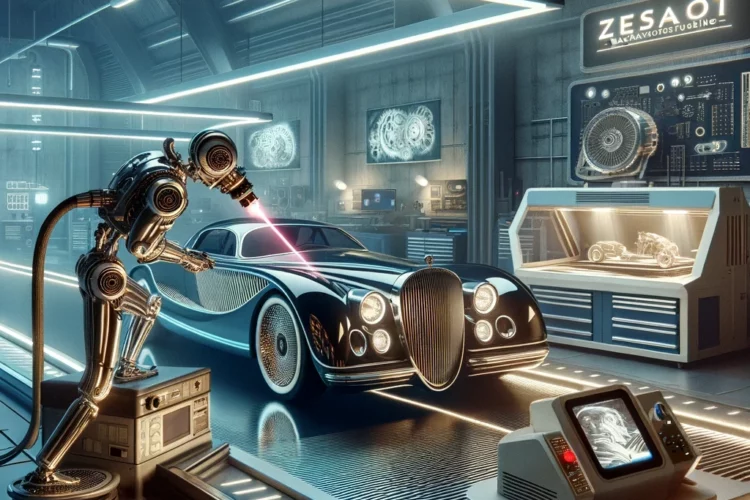
I. Introduction to Restoring Classic Cars
II. Benefits of Using CNC Technology in Classic Car Restoration
III. Steps for Using CNC Technology in Classic Car Restoration
IV. Tips for Implementing CNC Technology in Classic Car Restoration
Classic cars have a special allure that can’t be denied. These vintage vehicles evoke a sense of nostalgia and charm that many car enthusiasts find irresistible. Whether it’s the sleek lines of a classic Mustang or the timeless elegance of a vintage Porsche, restoring classic cars is a labor of love that requires skill, patience, and dedication.
Restoring classic cars is not just about bringing a piece of automotive history back to life; it’s also about preserving a piece of our collective heritage. Classic cars are a tangible link to the past, showcasing the craftsmanship and design sensibilities of bygone eras. For many car enthusiasts, restoring classic cars is a way to honor the legacy of these iconic vehicles and keep their spirit alive for future generations to enjoy.
But restoring classic cars is no easy feat. It requires a keen eye for detail, a steady hand, and a deep understanding of automotive mechanics. Every part of the restoration process must be carefully planned and executed to ensure that the final result is a true masterpiece. That’s where CNC technology comes in.
CNC technology, short for Computer Numerical Control, has revolutionized the field of classic car restoration. By using computer-controlled machines to automate the manufacturing process, CNC technology allows for greater precision and accuracy in creating custom parts and components for classic cars. This technology has made it easier than ever to restore classic cars to their former glory, helping enthusiasts bring their dream cars back to life.
In this guide, we will explore the benefits of using CNC technology in classic car restoration, as well as provide tips and advice for implementing this technology in your own restoration projects. Whether you’re a seasoned restoration expert or a novice looking to dive into the world of classic cars, CNC technology can help take your projects to the next level. So buckle up and get ready to discover the wonders of restoring classic cars with CNC technology!
Benefits of Using CNC Technology in Classic Car Restoration
Hey there, fellow classic car enthusiasts! If you’re looking to restore a vintage beauty to its former glory, you might want to consider incorporating CNC (Computer Numerical Control) technology into your restoration process. But why, you may ask? Well, let me enlighten you on the numerous benefits that CNC technology can bring to the table when it comes to restoring classic cars.
1. Precision and Accuracy
One of the biggest advantages of using CNC technology in classic car restoration is the level of precision and accuracy it offers. CNC machines are capable of performing intricate and complex cuts and shapes with utmost accuracy, ensuring that every part and component fits perfectly into place. This precision is crucial when working on vintage cars, as even the slightest deviation can affect the overall performance and aesthetics of the vehicle.
2. Replicating Original Parts
When restoring classic cars, finding original parts can be a challenge. With CNC technology, you can easily replicate those hard-to-find components with precision and accuracy. Whether it’s a custom bracket, a complex gear, or a unique trim piece, CNC machines can reproduce these parts exactly as they were in the original vehicle.
3. Time and Cost Efficiency
Restoring a classic car can be a time-consuming and costly endeavor, especially when dealing with custom or rare parts. CNC technology can help streamline the restoration process by reducing the time and cost required to manufacture parts. With CNC machines, you can create multiple identical parts in a fraction of the time it would take using traditional methods, saving you both time and money in the long run.
4. Versatility and Flexibility
CNC machines are incredibly versatile and can be used to create a wide range of components and parts for your classic car restoration project. Whether you need to cut, drill, mill, or engrave, CNC technology can handle it all with precision and efficiency. This flexibility allows you to tackle a variety of restoration challenges with ease, ensuring that your vintage car looks and performs its best.
5. Future-Proofing Your Restoration
By incorporating CNC technology into your classic car restoration project, you’re future-proofing your work. CNC machines are constantly evolving and improving, offering new capabilities and features that can enhance your restoration efforts. By investing in CNC technology now, you’re ensuring that your vintage car restoration will stand the test of time and continue to impress for years to come.
So, there you have it! The benefits of using CNC technology in classic car restoration are truly remarkable. From precision and accuracy to time and cost efficiency, CNC technology offers a wide range of advantages that can elevate your restoration project to the next level. So why wait? Embrace the power of CNC technology and bring your vintage beauty back to life in style!
Steps for Using CNC Technology in Classic Car Restoration
So you’ve decided to delve into the world of classic car restoration using CNC technology – that’s great! With the precision and efficiency that CNC machines offer, your project is sure to turn out amazing. Here are the steps to get you started:
- Research: Before diving in, it’s important to do your research on CNC technology and how it can be applied to classic car restoration. Understanding the capabilities and limitations of CNC machines will help you make informed decisions throughout the process.
- Design: Once you have a good grasp of CNC technology, it’s time to start designing your restoration project. Whether you’re replicating a missing part or customizing a component, creating a detailed design is crucial for CNC machining.
- Choose the Right CNC Machine: There are various types of CNC machines available, each with its own set of capabilities. Depending on the complexity of your project, you’ll need to choose the right CNC machine that can handle the size and intricacy of the parts you’re working on.
- Programming: After finalizing your design and selecting the appropriate CNC machine, the next step is programming. This involves converting your design into a format that the CNC machine can understand. Precision is key here, as any errors in the programming can affect the outcome of your restoration project.
- Set Up the CNC Machine: With the programming completed, it’s time to set up the CNC machine. This includes securing the material to be machined, loading the necessary tools, and calibrating the machine to ensure accurate cutting and shaping of the parts.
- Run the Machining Process: Once everything is in place, it’s time to run the machining process. Keep a close eye on the machine during this phase to ensure that everything is running smoothly and that the parts are being machined according to your design.
- Quality Check: After the machining process is complete, it’s important to conduct a thorough quality check of the parts. Inspect them for accuracy, precision, and any defects that may have occurred during machining. Making adjustments at this stage will ensure that the parts meet your expectations.
- Assembly: Finally, once you’re satisfied with the quality of the machined parts, it’s time to assemble them into your classic car. Pay close attention to fit and finish, ensuring that the parts align perfectly with the rest of the vehicle.
By following these steps, you’ll be well on your way to successfully using CNC technology in your classic car restoration project. Remember, practice makes perfect, so don’t be discouraged if things don’t go smoothly the first time. With patience and persistence, you’ll soon master the art of using CNC technology to bring new life to classic cars.
Tips for Implementing CNC Technology in Classic Car Restoration
So, you’ve decided to delve into the world of classic car restoration and use CNC technology to bring your vintage beauty back to life. Congratulations! You’re about to embark on an exciting journey that will not only challenge your skills but also bring immense satisfaction and pride. Here are some tips to help you make the most out of this innovative technology:
- Do Your Research: Before diving headfirst into using CNC technology for classic car restoration, take the time to research and understand how it works. Familiarize yourself with the software, tools, and materials needed for this process. This knowledge will empower you to make informed decisions and troubleshoot any issues that may arise along the way.
- Start Small: If you’re new to CNC technology, it’s best to start with smaller projects before moving on to more complex tasks. Practice using the equipment and software on scrap materials to gain confidence and hone your skills. This way, you’ll be better prepared to tackle the restoration of your classic car with precision and accuracy.
- Collaborate with Experts: Don’t hesitate to seek guidance from experienced professionals in the field of classic car restoration and CNC technology. They can offer invaluable advice, tips, and tricks that will help you navigate the challenges of using this advanced technology. Collaborating with experts will not only enhance your restoration project but also expand your knowledge and expertise in the field.
- Stay Organized: Keeping your workspace neat and organized is crucial when using CNC technology for classic car restoration. Labeling tools, materials, and parts will help you stay on track and prevent any costly mistakes. Developing a systematic approach to your restoration project will streamline the process and ensure efficient results.
- Practice Patience: Restoring a classic car using CNC technology is a time-consuming process that requires patience and perseverance. Don’t rush through the project or cut corners to save time. Take your time to meticulously plan and execute each step of the restoration process. Remember, good things come to those who wait, and the end result will be well worth the effort.
By following these tips and incorporating CNC technology into your classic car restoration project, you’ll be well on your way to breathing new life into your vintage beauty. Embrace the challenges, enjoy the journey, and revel in the satisfaction of restoring a classic car to its former glory with the help of innovative technology. Happy restoring!










Comments